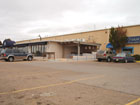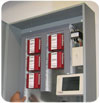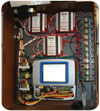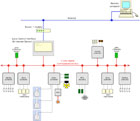
If you, as the owner of a luxury home, had a choice between having a hot tub in that home, or the ability to monitor the home’s temperature and security via the Internet, which would you choose? About 60% of the people polled on this question in Central Colorado chose Web-accessible monitoring and control of their home.
Although this resort home market is a bit outside the mainstream when it comes to ownership cost, and occupancy schedules, it still reflects a growing trend: The ability to monitor and adjust the HVAC, security, and lighting within a building from remote locations is definitely something owners see as added value and added peace of mind.
Web-enabled control of HVAC and security systems is certainly not new. It’s been incorporated into Direct Digital Control (DDC) systems in larger commercial buildings since the Internet became readily-accessible. What is new is the ability to scale this technology down in both complexity and cost to the point where it’s a realistic option for residential and light commercial buildings.

Knowing the Way in Santa Fe
Mike Ortiz is assistant manager at the Santa Fe branch of Dahl Wholesale. For years, Dahl has served a rapidly growing local market for radiant panel heating. According to Ortiz, about 80% of the new custom homes in the Santa Fe market are built with in-slab radiant floor heating. This, combined with a dry and sunny summer climate, creates an excellent market opportunity for hydronics technology.Dahl provides plenty of design assistance to local contractors who need solutions for customized heating and cooling systems. Their building (Figure 1) provides a working demonstration and hands-on training facility for some of the latest Web-enabled building automation systems.
The recently remodeled facility is now heated and cooled using six zoned air handlers that operate with either hot water or chilled water. The hot water is provided from a staged modulating boiler system. The chilled water is sourced from a 120-gallon buffer tank that’s maintained at suitable temperatures by a four-stage air-cooled chiller system. Each air handler can independently switch between heating and cooling as required. A pair of three-way diverter valves for each air handler coil selects either heated or chilled water. A schematic of the system is shown in Figure 2.
The entire system is now controlled by an iWorx building automation system. This system uses separate modules for controlling the staged boiler system, diverter valves, and circulators. These modules are all connected using 2-wire cable to form a LON-based network. All operating parameters can be entered, displayed, or logged at the LCI (Local Control Interface) module, which also acts as the system’s Internet server, enabling the same parameters to be monitored and changed from a Web page that’s automatically configured by the system. (See Figure 3)
Besides regulating HVAC, the iWorx system provides building access control via card readers and electronic locks, and will soon be expanded to include lighting control. These functions also can be monitored and adjusted from either the LCI module or the Web.

Rocky Mountain High Opportunity
Stu Lorton and Chris Allen of Climate Control Co. in Glenwood Springs, CO, provide HVAC solutions for some very “high-end” homes and commercial facilities in world-class resort areas. The systems they install often involve a combination of hydronic radiant panel heating, chilled water cooling, snowmelting, and ventilation.Getting all the hardware in these sophisticated systems to operate in a coordinated manner is no small task. Neither is ensuring that they remain operating as intended, especially when no one’s around to call for service. This combination of complex system requirements in frequently unoccupied buildings is ideally suited for Web-accessible control.
Stu and Chris recently upgraded a Vail-area home to an iWorx control system. During an earlier remodeling, the property was equipped with home automation for security and indoor temperature settings. The new iWorx system (Figure 4) was configured to interact with the home automation system, receiving indoor temperature settings directly from it. This extended Web-enabled HVAC control and monitoring functions well beyond the capabilities of the other system, allowing Climate Control Co. to monitor the HVAC systems and be automatically informed of any malfunctions.

Laptop vs. Screwdriver
Two important benefits set these control systems in these projects apart from standard HVAC control options:1. The controllers can communicate:Although several stand-alone controllers can be used to regulate heating, cooling, access control, energy metering, and lighting, the installed cost of such an arrangement would be far higher than that of a fully-communicating system.
For example, all settings and performance information for the iWorx systems in these projects can be displayed on one Local Control Interface module. A system with stand-alone controllers requires separate displays on every controller. This is certainly reflected in the cost of each stand-alone controller.
Another example is sensor count. Many control functions in a typical HVAC control system reference outdoor temperature. With stand-alone controllers, a separate outdoor sensor is required for any controller that references this temperature. In a communicating control system, a single outdoor sensor provides the temperature to any controller on the network that requests it.
Beyond elimination of redundant components are the issues of complexity and compatibility. When several stand-alone controllers are merged into an overall system, there’s always a chance for unforeseen conflicts between controllers that inadvertently “overlap” in operating responsibility. Separate controllers, especially when supplied by different companies, also make the overall system more difficult for technicians to configure and troubleshoot.
2. The control systems are Web-enabled:With the appropriate administrative password, all control functions can be monitored and modified from anywhere there is Internet access. Imagine using your iPhone to change the temperature setpoints in a Montana lodge while sitting in an East-coast airport.
Furthermore, any control parameter can be logged over time to help diagnose if and when improper operation occurs. Alarm functions can be created and automatically reported via e-mail. The latter is especially useful in situations where buildings are frequently unoccupied. It even creates new business opportunities for building systems monitoring.
According to Chris at Climate Control Co., thehardwarecost of providing these capabilities is comparable with other control solutions that don’t provide Web-accessibility. However, he goes on to point out that therealsavings is in providing this capability without involving a third party to program the system. The latter makes the iWorx systems they install about 50% less expensive than third-party programmed DDC systems with similar capabilities.

Let's Talk
The concept of a networked, Web-enabled control system is shown inFigure 5.The red line represents a two-wire communications bus. These low-voltage wires carry digital communication signals between the controllers connected to the bus, but do not power these devices. Operating power is provided from a 24 VAC transformer. Line voltage power to operate larger devices such as circulators, fans, or compressors is handled by appropriately-sized relays or contractors operated by pilot relays within the controllers.
The physical location of any controller on the communications bus is irrelevant. Devices can be in close proximity, such as shown in Figures 3 and 4, or several hundred feet from each other if necessary. When a new device is attached to the bus, the Local Control Interface automatically detects it and assigns it the necessary address for communications. The iWorx system currently allows up to 64 LONWorks®-compatible devices to be connected to its communications bus.
The Local Control Interface has a touch-screen display that can report the status of any device on the network as well as change any setting. The LCI connects to a modem or router using a standard Ethernet cable. It generates a Web page based on the current configuration of the network and uploads that page to the Internet when needed.

Net Working
As in many other areas of technology, building automation has benefited from advances in microelectronics and Internet connectivity. It is now ready for deployment by the same contractors who install the heating and cooling equipment. It also is ready to generate new business opportunities – think building automation rather than simply HVAC control.It is time to get on the bus.
